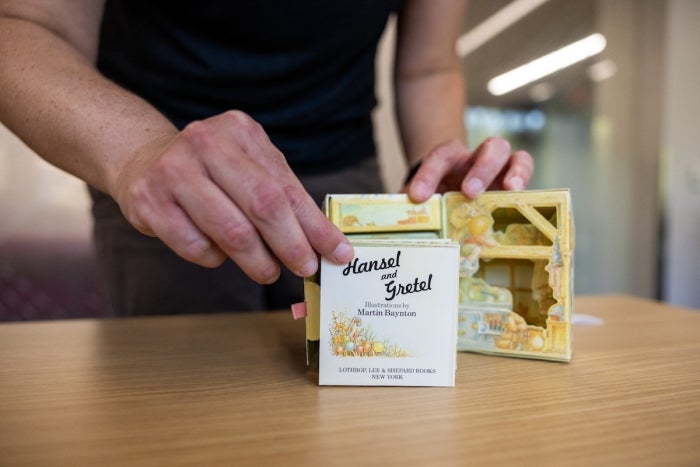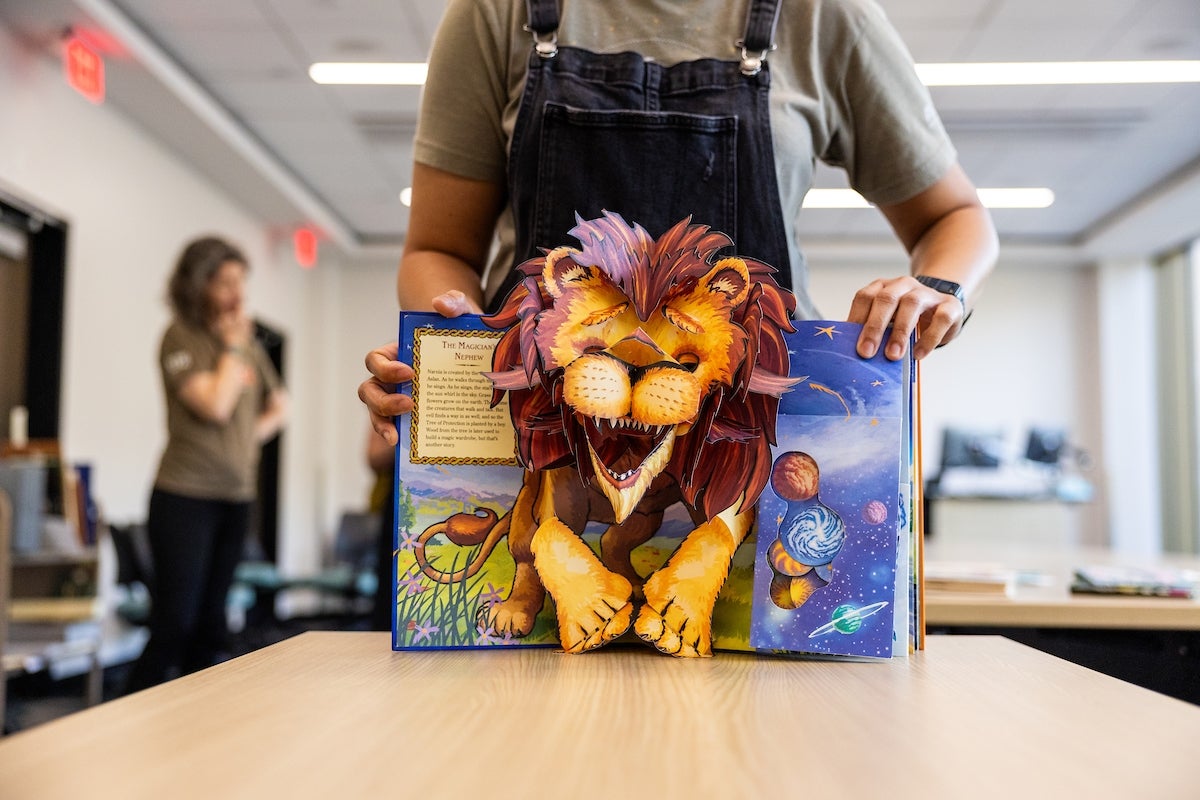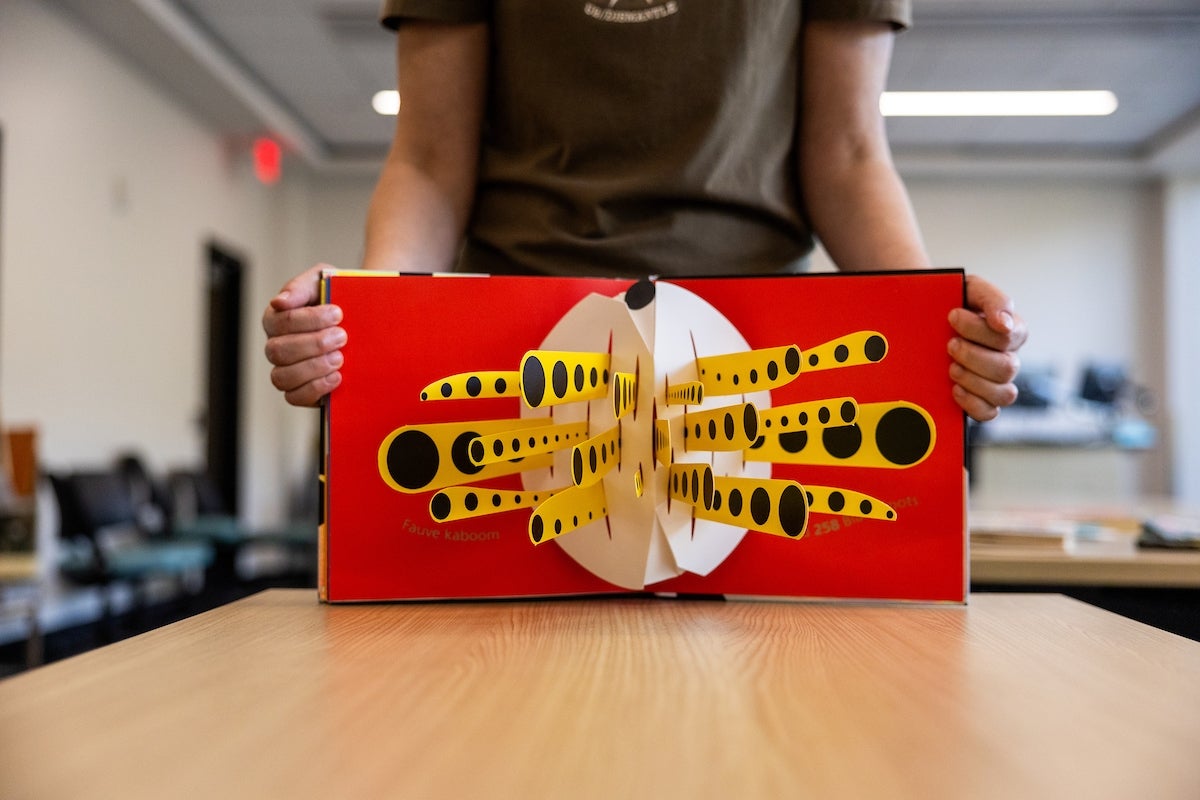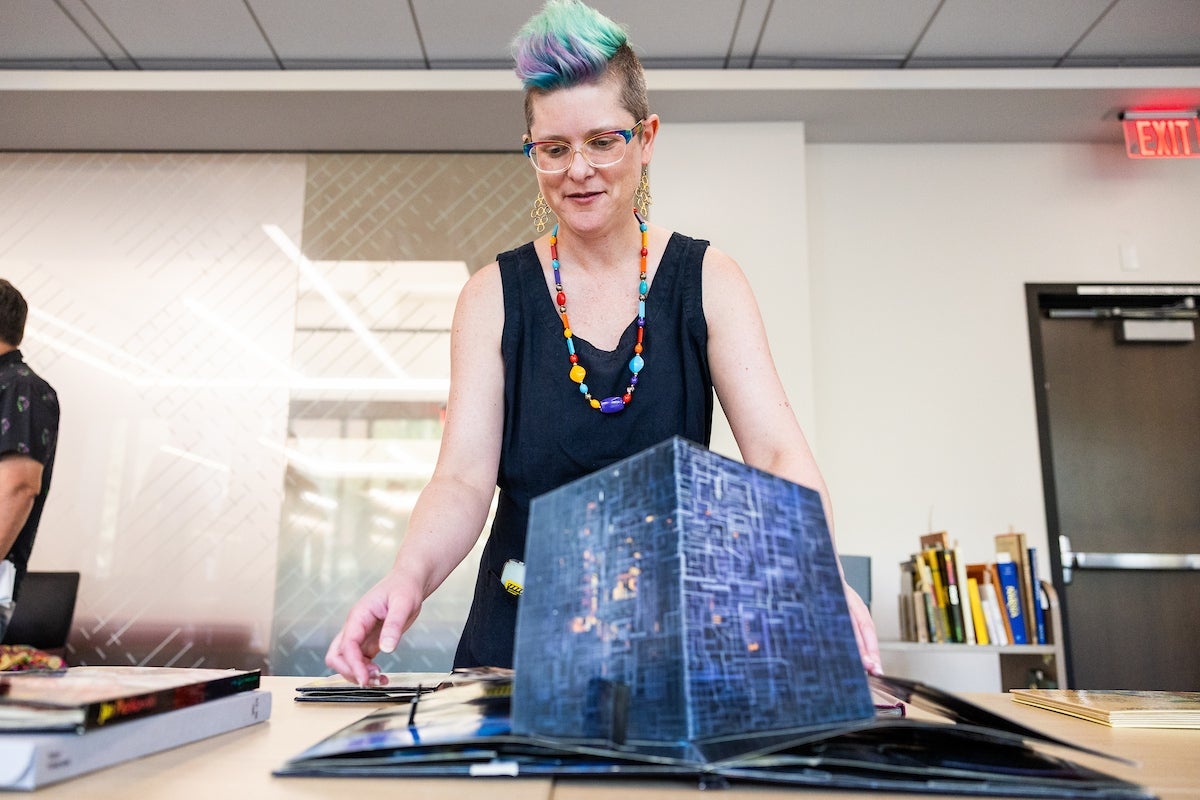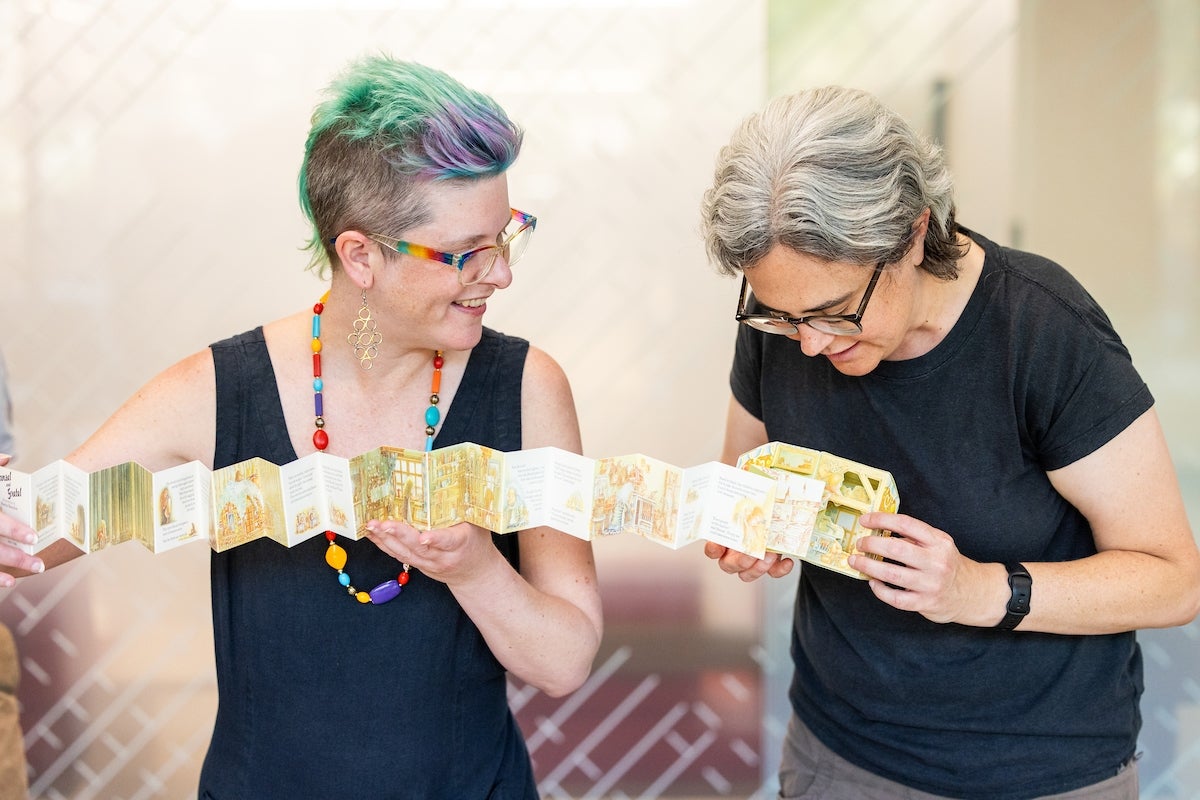ASU Library collection is deceptively simple fun

From left: Student workers Victoria Silva and Kathy Nazario, ASU Library Conservator Suzy Morgan and Shari Laster, head of Open Collections Curation and Access at ASU Library, handle books from the Eugene D. Valentine Collection. Photo by Deanna Dent/ASU
Editor’s note: This is part of a monthly series spotlighting special collections from ASU Library’s archives throughout 2024.
Arizona State University’s Eugene D. Valentine Collection is a whimsical and cheery repository of approximately 800 pop-up books, but that doesn’t mean it should be taken lightly.
Each book is considered an intricate work of art, with its designers spending untold hours bringing their paper-engineered constructions to life.
These movable book formats also have the potential to teach people something new — from Disney alphabet books to books on menopause, cigars and “Star Trek.” The secret to their allure is their ability to engage people of all ages from young children to adults.
See the collection
For questions about or to view materials in the Eugene D. Valentine Collection, reach out to the ASU Library’s Ask an Archivist service.
“These are books you have to read with your hands because they’re so inherently captivating,” said Suzy Morgan, who is the conservator for ASU Library. “They only work when you handle or manipulate them, and it requires you to engage. It’s one of the most interactive book formats there is because they’re both abstract and artistic. And they’re also really fun to read.”
The ASU Library received the bulk of these materials over a span of years from Valentine, a former faculty member in the Department of English and a charter member of the ASU Emeritus College, who passed in 2022. But the collection started in the late 1980s while on a road trip to Tucson, said colleague Daniel Mayer.
“Gene was a person who knew a lot about everything, and he was interested in everything — including printing, papermaking and all things book arts,” said Mayer, director of Pyracantha Press, the independent publishing imprint for collaborative, creative research in book arts and printmaking in ASU’s Herberger Institute for Design and the Arts.
“We heard about a microbiologist named James T. Sinski at the University of Arizona who would lecture every year and showcase his movable books in special collections," Mayer said. "After that visit, Gene and I visited a local bookstore and purchased some pop-up books. He loved the mechanisms in the books. And when I saw them, I was fascinated, too — by the history and art form that ranged from ciphers (and) early computers to engineering marvels.”
In addition to his pop-up book collection, Valentine established the Almond Tree Press for his publishing efforts. He also purchased a Vandercook Press in 1982, on which he hand-printed broadsides, books and special letter-pressed ephemera on paper made from plant fibers.
He and his wife Kristin were co-authors throughout their academic careers, taking sabbaticals together around the world and publishing both scholarly journals and textbooks in the fields of ethnography and human communication. He also used those trips abroad to diversify his pop-up collection.
“He bought books in England, the Czech Republic, Norway, Spain and New Zealand,” said his widow, Kristin Valentine. “He’d bring them home, read them to me, show me all the things that it did. He loved the creative engineering of how the paper would sprout up, then fold right back down. He thought they were works of art.”
Millions of others feel the same way, said Morgan.
“These books are works of art in their own way because there’s so much engineering and design that goes into a pop-up book,” Morgan said. “Lots of hand labor goes into these books because they aren’t made by machines. All the pieces must be glued and attached by hand, and many people are involved in the planning and creation of these. It’s a lot of time and effort.”
While pop-up books are a 19th century phenomenon, movable books that charted stars, planets and religious holidays actually date back to the 1300s and have been created for both children and adult audiences — exploring themes such as religion, science, health, politics, entertainment and the arts. They were used in scholarly manuscripts, teaching manuals, architectural drawings and religious devotionals.
Some of the leaders and innovators in the field include Lothar Meggendorfer, Ernest Nister, Vojtěch Kubašt, Jan Pieńkowski, David A. Carter and Robert Sabuda. Most of the books in the collection reflect Valentine’s tastes, which are heavily illustrated and feature mechanisms such as volvelles, movable discs, interactive flaps, sliders, tabs and pop-ups.
Shari Laster, head of Open Collections Curation and Access at ASU Library, said while the collection may not attract visiting scholars like some of the other repositories, it is an effective tool for university and community outreach.
“We use them for events when we open the doors to show people our special collections,” Laster said. “The first time I came in and saw a book that I recognized, it blew my mind we had this type of book in our collection. You never know what kind of formats may spark a lifelong passion for special collections and archives. Pop-up books are perfect for that.”
They are also teaching tools to those who pick them up and care to explore. That happened to Victoria Silva and Kathy Nazario, student workers at ASU Library.
“I was looking at a book called 'Illuminatomy' by Kate Davies that showed how the human body works with a three-color lens,” said Silva, who is graduating this year with a degree in animation. “These lenses separated the skeleton, muscles and organs, and it made me wonder how I could do that in a design process in printmaking and animation.”
Nazario said she didn’t have a library nearby where she grew up, and this collection introduced her to the world of pop-up books. She said she was drawn to “The Dwindling Party” by Edward Gorey, which tells the story of a family who tours an estate, and each meets a tragic ending.
“It’s got a lot of dark humor, but the mechanics, construction and paper sculptures are so beautiful,” said Nazario, a fourth-year animation major. “The content really surprised me, but it also showed me that these books can be about almost anything. It’s totally up to the author’s imagination.”
While the books offer plenty of stimulation, they require a lot of care for upkeep. Because of the hands-on nature of how movable books are used, they are kept in special collections so that visitors can handle them carefully in the Wurzburger Reading Room. Repairs can require a delicate process.
“Pop-up books have an unusual anatomy compared with other book formats, which means they break in different ways,” Morgan said. “When they get damaged, we basically need to reverse-engineer how they were constructed.”
Laster said that the collection is here for current and future generations to discover pop-up books of the past and present, and ASU Library will continue to be selective in how it will grow in the future.
“If there’s a gift offered to us, we might review it and see if it brings something distinctive to our collection, especially if it represents a new or innovative form of construction,” Laster said. “We are very proud of what we already have.”
That makes Kristin Valentine very happy.
“It’s very gratifying and important that the ASU Library values this collection and has done a great job preserving it,” Valentine said. “It’s Gene’s legacy.”
Monthly series spotlighting ASU Library’s special collections
- January: Expanded Theatre for Youth and Community Collection remains a repository for emerging artists and educators
- February: Black Collections aims to document the lives of an underrepresented Arizona community
- March: Voices from Latin America can be found in dynamic research collection
- April: Thunderbird archives: These walls do talk
- May: Collection preserves legacy of modern architects, buildings in the Southwest
- June: LGBTQ+ Studies Collection a repository rich in legacy
- July: Pop-up book collection is deceptively simple fun
- August: A (re)source of Sun Devil pride
- September: Chicano/a Research Collection filled with action, education and activism
- October: ASU collections offer Indigenous perspective through traditional storytelling, innovative methodology
- November: University Archives chronicles more than 140 years of Sun Devil history
- December: Collection captures the robust history of Arizona
More Arts, humanities and education

Professor's acoustic research repurposed into relaxing listening sessions for all
Garth Paine, an expert in acoustic ecology, has spent years traveling the world to collect specialized audio recordings.He’s been to Costa Rica and to Ecuador as part of his research into innovative…

Filmmaker Spike Lee’s storytelling skills captivate audience at ASU event
Legendary filmmaker Spike Lee was this year’s distinguished speaker for the Delivering Democracy 2025 dialogue — a free event organized by Arizona State University’s Center for the Study of…

Grammy-winning producer Timbaland to headline ASU music industry conference
The Arizona State University Popular Music program’s Music Industry Career Conference is set to provide students with exposure to exciting career opportunities, music professionals and industry…


